Handwriting improvement Normal Letter Recognition Worksheets for Ages 6-9
3 filtered results
-
From - To
Enhance your child's handwriting and letter recognition skills with our engaging Normal Letter Recognition Worksheets designed for ages 6-9. These thoughtfully crafted worksheets provide a fun and interactive approach for young learners to master the alphabet through tracing, identifying, and practicing each letter. Perfect for reinforcing fine motor skills and enhancing cognitive development, our materials are aligned with educational standards to ensure effective learning. As children work through these activities, they will build confidence in their handwriting abilities while also developing essential literacy skills. Empower your child’s educational journey with our handwriting improvement resources today!


Is it b, p or d? Worksheet


Letter J Tracing Page


Letter B Tracing Page
Handwriting improvement and normal letter recognition are crucial skills for children aged 6 to 9, as they lay the foundation for effective communication and academic success. During these formative years, children are transitioning from learning to read and write to using these skills to express their thoughts and ideas effectively. Parents and teachers should prioritize handwriting and letter recognition because they significantly impact a child's self-esteem, motivation, and overall learning experience.
Good handwriting promotes clarity in written communication, allowing children to convey their ideas without frustration. Children with neat, legible writing are more likely to take pride in their work and participate actively in classroom discussions. Additionally, mastering letter recognition is fundamental for reading proficiency, helping children decode words and improve their comprehension skills.
Furthermore, consistent practice in these areas encourages fine motor skills development, which is essential for overall physical coordination. By nurturing handwriting and letter recognition abilities early on, parents and educators equip children with the tools necessary for lifelong learning. Ultimately, supporting these skills fosters a love for writing and reading, key components of a child’s educational journey, making it imperative for caring adults to engage in this vital aspect of learning.

 Assign to My Students
Assign to My Students




















